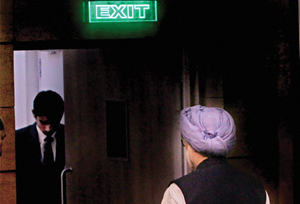 Mumbai, Jan 4: Was it Manmohan Singh? Or was it a robot? To a neutral observer, the difficult answer would be that it was both.
Mumbai, Jan 4: Was it Manmohan Singh? Or was it a robot? To a neutral observer, the difficult answer would be that it was both.
At the end of close to 10 years in office, latent mechanical qualities like passivity, subservience and obedience that must have come in handy for survival at the top, have finally won the battle for the upper hand. The machine in the man spoke on Friday, and both self-styled achievements — growth rate, rural welfare, educational reforms, etc — and self-confessed failures — low employment and high food prices — acquired the same grey monotonous hum of a pre-recorded statement, rendering triumph indistinguishable from tragedy.
For a PM, an appearance before the media is not so much to do with his self-appraisal as selling an image. The image that the PM sold to the nation on Friday was that of a man bidding farewell.
He had done his job to the best of others’ abilities and he was now reconciled to not being thanked too warmly. The prime minister, it appeared, was by now used to expect nothing from the world.
Naturally, he was grim. Certainly, not a smile broke through his features. Whatever happened to those witty lines that Manmohan Singh laced his budget speeches as finance minister in the not too distant past, when Rahul Gandhi hadn’t yet developed the compulsive habit of tearing up ordinances and taking chief ministers to task in public. For someone, who has been in power for two successive terms, Manmohan Singh exuded the air of a man who had seen the end of an era in the mirror that very morning when he was tying the turban.
In the question-and-answer session following his speech, Manmohan Singh was again his inanimate self — at odds with the new virtual world.
In a tone devoid of emotions so natural to the living, he downgraded Narendra Modi’s credentials as a prime ministerial candidate and, in the exactly joyless manner of speech, appreciated Rahul Gandhi’s leadership potential. Praise never sounded so dull as when Manmohan Singh sang it.
The concluding lines of Manmohan Singh’s speech said his government would “revive growth, promote enterprise, generate employment, eliminate poverty and ensure safety and security of all our people, particularly our women and children.” No one listening could have believed him. The words were too repetitive to bear hope. And the prime minister looked as tired as the words.
Perhaps, what made Manmohan Singh think it was a bit too much, what with a billion endless expectations, was how it all started over ten years ago with such fanfare, when destiny had thrust greatness on him as the accidental architect of a “reformed India.” Halfway through in 2009, after he went in for a bypass, politics and life had become an elaborate, extended joke. His heart probably was not in it anymore. Politics was too complex a game. Survival was the collateral damage in the hunt for greatness. There must have been occasions in those ten years when Manmohan Singh asked himself: have I blown it?
And the answer, as it turns out, is yes, mostly. Manmohan Singh lost his resolve halfway through.
Which is why on Friday as Manmohan Singh faced the cameras grimly, the only real message that came through was that he was waiting for his term to end. It must console him that exit (as shown in the accompanying picture) is at hand. And he may be relieved that there was no wild applause at the back as he made egress, and the stage readied for someone else.






Comments
Add new comment